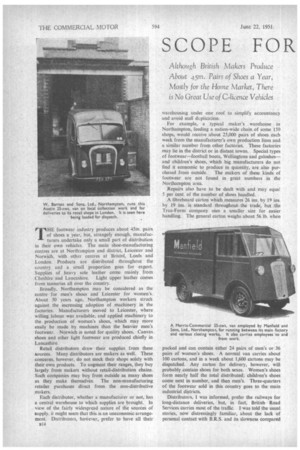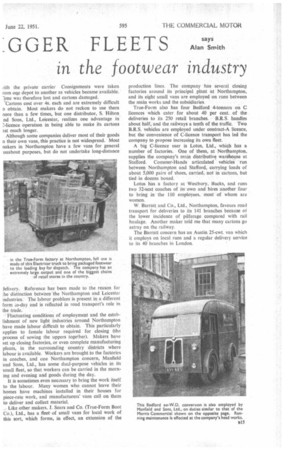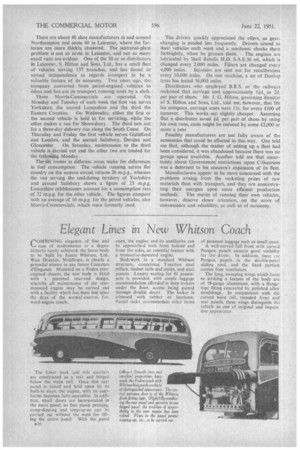SCOPE FOR .GGER FLEETS
Page 48

Page 49

Page 50

If you've noticed an error in this article please click here to report it so we can fix it.
in the footwear industry says Alan Smith
Although British Makers Produce . About • 457n. Pairs • of Shoes a Year, Mostly for the Home Market, There is No Great Use of C-licence Vehicles
THE footwear industry produces about 45m pairs of shoes a year, but, strangely enough, manufacturers undertake only a small part of distribution in their own vehicles. The main shoe-manufacturing centres are at Northampton and district, Leicester and Norwich, with other centres at Bristol, Leeds and London. Products are distributed throughout the country and a small proportion goes for export. Supplies of heavy sole leather come mainly from Cheshire and Lancashire. Light upper leather comes from tanneries all over the country.
Broadly, Northampton may be considered as the centre for men's shoes and Leicester for women's. About 50 years ago, Northampton workers struck against the increasing adoption of machinery in the factories. Manufacturers moved to Leicester, where willing labour was available, and applied machinery to the production of women's shoes, which may more easily be made by machines than the heavier men's footwear. Norwich is noted for quality shoes. Canvas shoes and other light footwear are produced chiefly in Lancashire.
Retail distributors draw their supplies from these sources. Many distributors arc makers as well. These concerns, however, do not stock their shops solely with their own products. To augment their ranges, they buy largely from makers without retail-distribution chains. Such companies may buy from outside as many shoes as they make themselves. The non-manufacturing retailer purchases direct from the non-distributive makers.
Each distributor, whether a manufacturer or not, has a central warehouse to which supplies are brought. In view of the fairly widespread nature of the sources of supply, ii might seem that this is an uneconomic arrangement: Distributors, hoWever, prefer to have all their B14
.warehousing under one roof to simplify, accountancy and avoid staff duplication.
For example, a typical maker's warehouse in Northampton, feeding a nation-wide chain of some 150 shops, would receive about 25,000 pairs of shoes each week from the manufacturer's own production lines and a similar number from other factories. These factories may lie in the district or in distant towns. Special types of footwear—football boots, Wellingtons and galoshes— and children's shoes, which big manufacturers do not find it economic to produce in quantity, are also purchased from outside. The makers of these kinds of footwear are not found in great numbers in the Northampton area.
Repairs also have to be dealt with and may equal 5 per cent. of the number of shoes handled.
A fibreboard carton which measures 26 ins. by 19 ins. by 19 ins, is standard throughout the trade, but the True-Form company uses a smaller size for easier handling. The general carton weighs about 56 lb. when packed and can contain either 24 pairs of men's or 36 pairs of women's shoes. A normal van carries about 100 cartons, and in a week about 1,600 cartons may be dispatched. Any carton for delivery, however, will probably contain shoes for both sexes. Women's shoes form nearly half the total distributed; children's shoes come next in number, and then men's. Three-quarters of the footwear said in this country goes to the main industrial districts.
Distributors, I was informed, prefer the railways for long-distance deliveries, but, in fact, British Road Services carries most of the traffic. I was told the usual stories, now distressingly familiar, about the lack of personal contact with B.R.S. and its slowness compared iith the private carrier Consignments were taken rom one depot to another as vehicles became available. rime was therefore lost and cartons damaged.
Cartons cost over 4s. each and are extremely difficult obtain. Most makers do not reckon to use them nore than a few times, but one distributor, S. Hilton nd Sons, Ltd., Leicester, realizes one advantage in -licence operation in being able to make its cartons 1st much longer.
Although some companies deliver most of their goods n their own vans, this practice is not widespread. Most nakers in Northampton have a few vans for general unabout purposes, but do not undertake long-distance lelivery. Reference has been made to the reason for he distinction between the Northampton and Leicester [industries. The labour problem is present in a different form to-day and is reflected in road transport's role in the trade.
Fluctuating conditions of employment and the establishment of new light industries around Northampton have made labour difficult to obtain. This particularly applies to female labour required for closing (the process of sewing the uppers together). Makers have set up closing factories, or even complete manufacturing plants, in the surrounding country districts where labour is available. Workers are brought to the factories in coaches, and one Northampton concern, Manfield and Sons, Ltd., has some dual-purpose vehicles in its small fleet, so that workers can be carried in the morning and evening and goods during the day.
It is sometimes even necessary to bring the work itself to the labour. Many women who cannot leave their homes have machines installed in their houses for piece-rate work, and manufacturers' vans call on them to deliver and collect material.
. Like other makers, J. Sears and Co. (True-Form Boot Co.), Ltd., has a fleet of small vans for local work of this sort, which forms, in effect, an extension of the production lines. The company has several closing factories around its principal plant at Northampton, and its eight small vans are employed on runs between the main works and the subsidiaries.
True-Form also has four Bedford 4-tonners on C licences which cater for about 40 per cent. of the deliveries to its 250 retail branches. B.R.S. handles about half, and the railways a tenth of the traffic. Two B.R.S. vehicles are employed under contract-A licence, but the convenience of C-licence transport has led the company to propose increasing its own fleet.
A big C-licence user is Lotus, Ltd., which has a number of factories. One of them, at Northampton, supplies the company's main distributive warehouse at Stafford. Commer-Hands articulated vehicles run between Northampton and Stafford, carrying loads of about 5,000 pairs of shoes, carried, not in cartons, but tied in dozens boxed.
Lotus has a factory at Westbury. Bucks, and runs two 32-seat coaches of its own and hires another four to bring in the 110 employees, most of whom are women.
W. Barratt and Co., Ltd., Northampton, favours road transport for deliveries to its 141 branches because ot the lower incidence of pilferage compared with rail haulage. Another maker told me that many cartons go astray on the railway.
The Barratt concern has an Austin 25-cwt. van which it employs on local runs and a regular delivery service to its 40 branches in London. There are about 40 shoe manufacturers in and around Northampton and some 60 in Leicester, where the factories are more thickly clustered. The scattered-plant problem is not so acute in Leicester, and not so many small vans are evident. One of the 30 or so distributors in Leicester, S. Hilton and Sons, Ltd., has a small fleet of vehicles serving 137 branches, and has found its virtual independence as regards transport to be a valuable feature of its economy. Two years ago, the company converted from petrol-engined vehicles to oilers and has.cut its transport running costs by a sixth.
Three Morris-Commercials are operated. On Monday and Tuesday of each week the first van serves Yorkshire, the second Lancashire and the third the
Eastern Counties. On Wednesday, either the first or the second vehicle is held in for servicing, while the other makes a run for Shrewsbury. The third sets out for a three-day delivery run along the South Coast. On Thursday and Friday the first vehicle serves Guildford and London, and the second Salisbury, Devizes and Gloucester On Saturday, maintenance to the third vehicle is carried out and the other two are loaded for the following Monday.
The set routes in different areas make for differences in fuel consumption. The vehicle running across flat country on the eastern circuit returns 26 m.p.g., whereas the van serving the undulating territory of Yorkshire and around Salisbury shows a figure of 23 m.p.g. Lancashire cobblestones account for a consumption rate .of 22 m.p.g. for the other sehicle. The figures compare with an average of 10 m.p.g for the petrol vehicles, also Morris-Commercials, which were formerly used.
The drivers quickly appreciated the oilers, as gearchanging is needed less frequently. Drivers attend to their vehicles each week and a mechanic checks them fortnightly, when he greases them.. • The engines are lubricated by Shell RoteIla H.D. S.A.E.30 oil, which is changed every 2,000 miles. Filters are changed every 4,000 Miles. Injectors are sent out for recalibration every 10,000 miles. On one machine, a set of Dunlop tyres has lasted 56,000 miles.
Distributors who employed B.R S. or the railways reckoned that carriage cost approximately lid. or 2d. per pair of shoes. Mr. J. G. Hilton, governing director of S. Hilton and Sons, Ltd., told me, however, that for his company, carriage costs were I Is. for every £100 of turnover. This works out slightly cheaper. Assuming that a distributor saved id. per pair of shoes by using his own vans, costs might he reduced by some £2,000 or more a year.
Possibly manufacturers are not fully aware of the economies that could be effected in this way. One told me that, although the matter of setting up a fleet had been considered, it was abandoned because there was no garage space available. Another told me that uncertainty about Government restrictions upon C-licensees was a deterrent to his concern's expansion of its fleet.
Manufacturers appear to be more concerned with the problems arising from the rocketing prices of raw materials than with transport, and they are concentrating their energies upon more efficient production methods. The merits of running their own vehicles, however, deserve closer attention, on the score of convenience and reliability, as well as of economy.




















































































